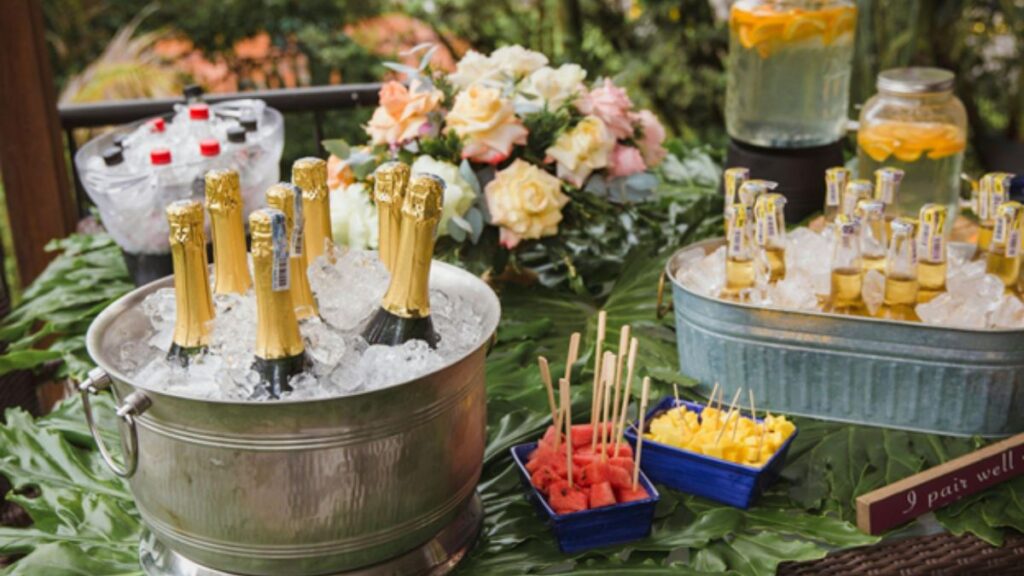A strong first impression sets the emotional tone for the entire event
Cohesive details like lighting, sound, and decor create a seamless guest experience
Engaging all five senses deepens the impact and makes the space immersive
Personal storytelling and unique touches turn events into lasting memories
You’ve probably been to events where everything looked picture-perfect, but something was missing. Maybe the lighting was harsh, the space felt cold, or there wasn’t that emotional spark. Now flip that memory. Think about an event where you walked in and immediately felt welcomed, curious, and enchanted. That’s the power of Creating Atmosphere—and it lingers in people’s memories far longer than any plated dinner or playlist ever will.
Whether planning a wedding, a corporate event, or a birthday celebration, creating a memorable atmosphere is the secret sauce that transforms “just another gathering” into a meaningful experience. In this post, we’ll unpack how small details, intentional design choices, and a few sensory tricks can completely change the vibe of your event. If you aim to make guests talk about your event long after it ends, you’re in the right place.
Let’s dive into how you can build that unforgettable feeling, step by step.
The Power of First Impressions
They say you never get a second chance to make a first impression, and that couldn’t be more true for events. The moment guests step into your space, they’re forming an opinion—whether they realize it or not. That entrance moment sets the tone for everything that follows, so why not make it count?
Think of the arrival as your first “wow” opportunity. A dramatic doorway framed with soft draping, subtle music humming in the background, or a soft wash of ambient lighting can instantly ease guests into the mood you’re trying to create. Even something as simple as a custom welcome sign, a light floral scent, or candles flickering near the entrance can hint that something special is waiting inside.
Texture matters too. Does the space invite people in or feel sterile and formal? Do your guests walk into a hallway of echoing tile, or are they met with cozy rugs, soft lighting, and intentional decor cues? Small touches create big emotions.
By focusing on how guests experience the space from the first step, you set yourself up for a memorable and emotionally resonant experience. First impressions are your chance to whisper to guests, “This isn’t another event.”
Details That Speak Louder Than Words
Once inside, it’s the details that do the real talking. And no, it’s not about overloading the room with visual noise—it’s about harmony. When every element works together, the space starts to tell a story. Your color palette, textures, and table settings all have a voice.
Maybe you’ve picked a soft, romantic theme with muted pinks and sage greens. Perhaps you’re going for modern chic with bold contrasts and metallic accents. Either way, the key is consistency. Don’t just style your tables—style the whole room so every corner feels intentional, not accidental.
Now, let’s talk florals. There’s a reason you see them at almost every event—they instantly elevate a space. But it’s not just about plopping down a vase of roses. The magic happens when the flowers complement your theme, echo your colors, and feel like a natural extension of your event’s personality. If you’re considering flowers for event design, think beyond the centerpiece. Floral runners, hanging installations, even petal-lined aisles can completely change the tone of your environment.
And here’s the best part: people notice. They may not remember the brand of champagne you served, but they’ll remember how that peony garland smelled, or how the soft florals made the whole room feel like a garden. Details like that don’t just decorate a space—they define it.
Lighting and Soundscapes That Set the Mood
Lighting does more than help people see—it helps them feel. Shifting the lights, you can transform a sterile conference hall into an intimate, moody lounge. Harsh overhead lighting can flatten a space and suck out the emotion, while a thoughtful blend of soft glows, warm tones, and flickering candlelight Creating Atmosphere that feels both cozy and luxurious.
Consider layering your lighting. Ambient lighting sets the overall tone, task lighting draws focus to specific elements (like a cake table or bar), and accent lighting adds that extra layer of intrigue. Uplighting along the walls, fairy lights overhead, or even unexpected pops like neon signs can subtly guide guests through the space while shaping their emotional response.
Sound plays a similar role. You don’t need a live band to make a space feel alive—you just need the right audio at the right volume. A soft instrumental track during dinner, the gentle hum of nature sounds at an outdoor ceremony, or even silence in certain moments can dramatically shift how people engage with the space. Good sound design isn’t loud—it’s intentional.
When lighting and audio are in sync, the atmosphere feels cohesive. It’s not just about what guests see or hear, but how both senses guide their emotional journey through the event.
Engaging All Five Senses
Most people plan events with their eyes—and sometimes their ears—in mind. But you need to think beyond the obvious to create a truly immersive atmosphere. You’ve got five senses to play with, each offering a chance to leave a lasting impression.
Let’s start with touch. You may not think about texture as a tool for design, but it can create comfort, contrast, and even curiosity. A velvet table runner, hand-written place cards on thick paper, or linen napkins tied with a satin ribbon are subtle, tactile details that guests notice without even realizing it.
Scent is another underused secret weapon. Our sense of smell is closely linked to memory, so the right fragrance can make your event unforgettable. Scent can create an emotional anchor for your event, whether it’s a signature candle, a floral arrangement with a strong natural aroma, or fresh herbs at each place setting.
Taste, of course, is a star in its own right—but think beyond the food itself. Can the drinks mirror the mood? Could dessert be presented playfully or unexpectedly? Even the timing of when flavors are introduced can help control the pacing and energy of the event.
When you design with all five senses in mind, the experience deepens. Guests don’t just attend—they feel, absorb, and remember.
Personalization and Storytelling
You can have the most stunning decor, but it risks feeling generic if it doesn’t reflect something real—your story, your personality, or your purpose. That’s where personalization steps in. When you infuse your event with thoughtful touches that reflect who you are or what it means, it instantly becomes more memorable.
Think of ways to tell a story through the space. Maybe it’s a photo wall that traces a couple’s relationship, handwritten notes tucked into each place setting, or table names inspired by inside jokes or shared experiences. These personal elements invite guests into your world and make them feel like participants, not just attendees.
Storytelling can also happen through the flow of the event. Each stage—from arrival to farewell—can mirror the arc of a narrative. Start with curiosity, move into moments of connection and delight, then end with a meaningful or unexpected touch that lingers. People remember stories. They retell them. When you Creating Atmosphere with that in mind, your event becomes part of their story.
Conclusion
Creating Atmosphere is more than decor—it’s a feeling, a mood, and a memory in the making. When you approach event planning with intention and attention to sensory details, you create something that resonates long after the chairs are stacked and the lights go out. Focus on what guests will feel, not just what they’ll see.
The most unforgettable experiences come from a thoughtful blend of design, emotion, and storytelling. When you get that right, your event doesn’t just impress—it leaves a lasting imprint.







